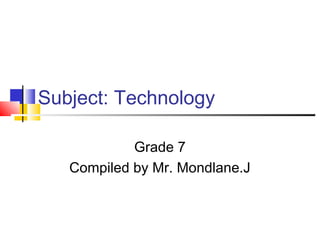
Technology grade7
- 1. Subject: Technology Grade 7 Compiled by Mr. Mondlane.J
- 2. Introduction Technology can defined as the use of knowledge, skills, values and resources to meet people’s needs wants by developing practical solution to problems, taking social and environmental factors into consideration.
- 3. Design process skills Investigate Problem Design Evaluate Communicate Make
- 4. Investigation Investigate is a situation to gain information is an important starting point for technology. Reseach or finding of information mainly take places here. Learner gather data and information , grasp concepts and gain insight, find out about new techniques.
- 5. Activity 1.1 Distinguish between needs and wants. In the table below separate needs and wants use the heading above. bracelet Sunglasses Magazine food Sunscreen Make up Water bottle hat Insect repellent Cushion Body lotion slipper
- 6. Design Once a problem is fully understood, the design brief needs to be written. possible solutions should then be generated. These ideas may be drawn on paper. This part of design process requires awareness and knowledge and skills associated with graphics, such as the use of colour , rendering techniques, 2D and 3D drawings. These in essence include abilities in planning, sketching, drawing , calculating, modelling, and resources. The chosen solution will be the one that best satisfies the specifications. At this point final drawing / sketches of the chosen solution should be prepared. 2D two- dimensional – a flat drawing , in which only two principle dimensions are visible 3D three-dimensional a pictorial drawing. A drawing in which the three principle dimensions are visible , also the three principle faces are visible in the one drawing.
- 7. Design Aspect of design The key aspects of design are the following: People: who will use the product. Purpose : what will the actual product will do? Appearance : what it will look like colour and shape this include what material will it will be made out of as well. Environment : how will the production and use of the product affect the environment? Safety : how is the product Cost: how much will the finished product cost to produce and what will be the selling price?
- 8. Make This aspect opportunities for learners to use tools, equipment and materials to develop a solution to the identified problem, needs or opportunity. It involve buildings, testing , modifying the product. Learner will cut , join, shape, finish, form, combine, assemble, measure, mark separate mix etc.
- 9. Evaluate Learners need to evaluate their actions, decisions and results through design process. Learners need to evaluate the solutions and the process followed to arrive at the solutions. They should able to suggest changes or improvements where necessary. This stage requires the use of probing questions, fair test, analysis, etc.
- 10. Communicate This could be done in various modes like oral, written, graphic or electronic presentation.
- 11. Fitness for purpose A solution should be evaluated in terms of the design brief, specifications constraints and whether it will meet the purpose for which it was designed.
- 12. Notes Investigation The investigation is about to find out about the need of the learners, based on my interview the learner have showed a big concerned about carrying textbooks, too much work to write it down and limited time , so it make difficult for them to keep up. So the learner requested to have LEARNERLAPBOOKS to reduce amount of work load that will have everything they will need for learning. Design Design is done according to the learners specifications which include features that enable learner do the work at home, programme that will teach learner, exercise. Make After design was success according to learner preference need was met the design of the LEARNERLAPBOOK have made. Evaluation Before the process of making learners LEARNERLAPBOOK for entire school we made the evaluation was carried out to check is to whether the learnerlapbook is working properly so that error to be ratified as early as possible. Communication This product will be introduced to the schools through media such as TV, billboard, oral presentation will also be done in schools and massive public. Fitness for purpose The product is design for learners and teachers , it to reduce amount of time of writing to chalkboard, it will make learning effective, it is safe to used no danger will be exposed for the users, it looks good, and have no effect to the environment.
- 13. Rough design
- 14. Design view
- 15. Book Case design view
- 16. Car design
